Evaluation of UK Government's Childhood Obesity Campaign: A Report
VerifiedAdded on 2020/12/18
|11
|3465
|90
Report
AI Summary
This report provides a comprehensive analysis of the UK government's 'Childhood Obesity: a plan for action' campaign. It begins with an introduction to the obesity crisis in the UK, highlighting the government's objectives to halve childhood obesity by 2030. The main body of the report examines the campaign's implementation, target audience, and funding strategies, including the role of the Department of Health and Social Care and various partnerships. It then evaluates the campaign's effectiveness, considering the use of social media and comparing it to other health initiatives. The report further details the campaign's strengths and weaknesses, with recommendations for improvement. The analysis includes a critical assessment of the campaign's impact, the role of media, and the application of theoretical models in health promotion. Overall, the report assesses the campaign's impact on the UK's public health, offering insights into its effectiveness and areas for enhancement.
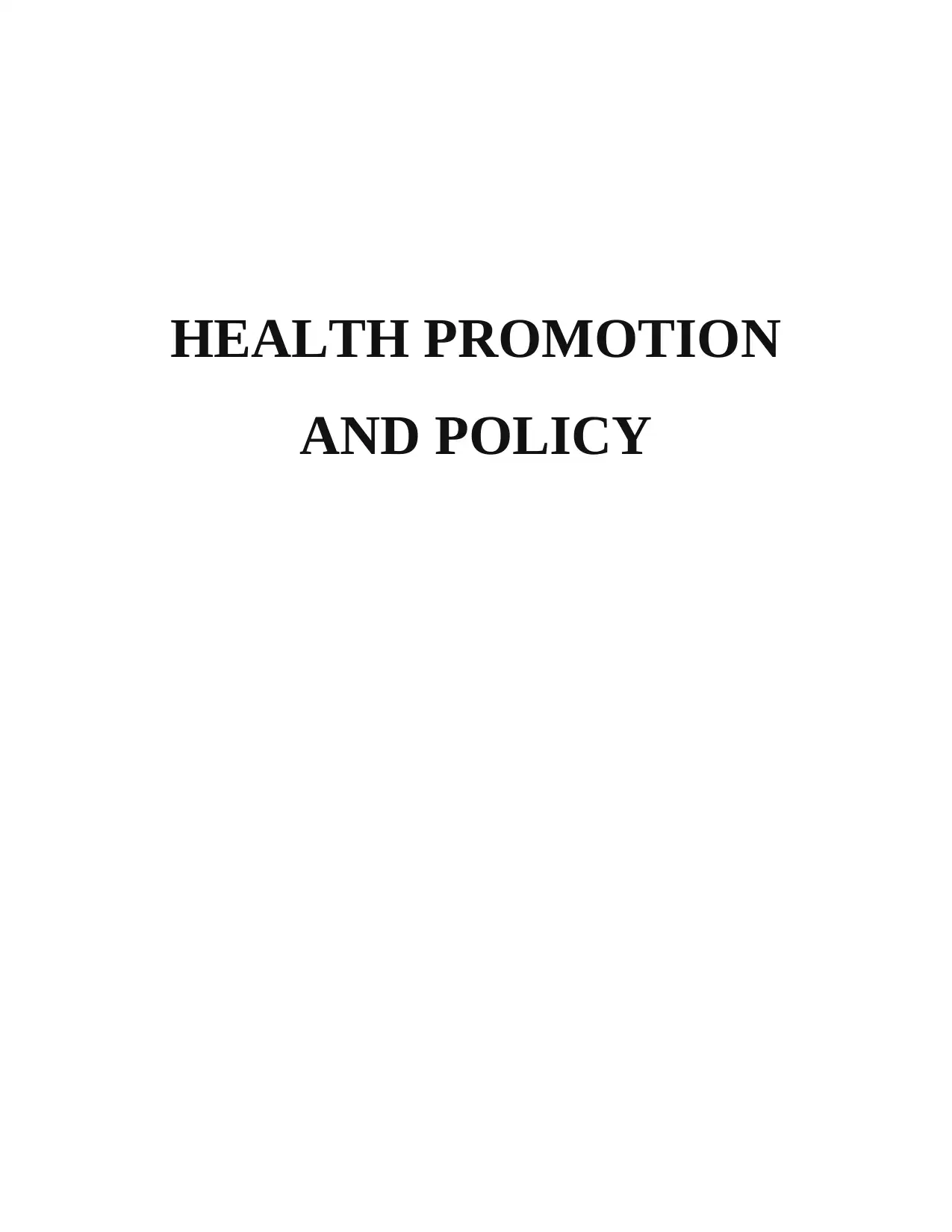
HEALTH PROMOTION
AND POLICY
AND POLICY
Paraphrase This Document
Need a fresh take? Get an instant paraphrase of this document with our AI Paraphraser
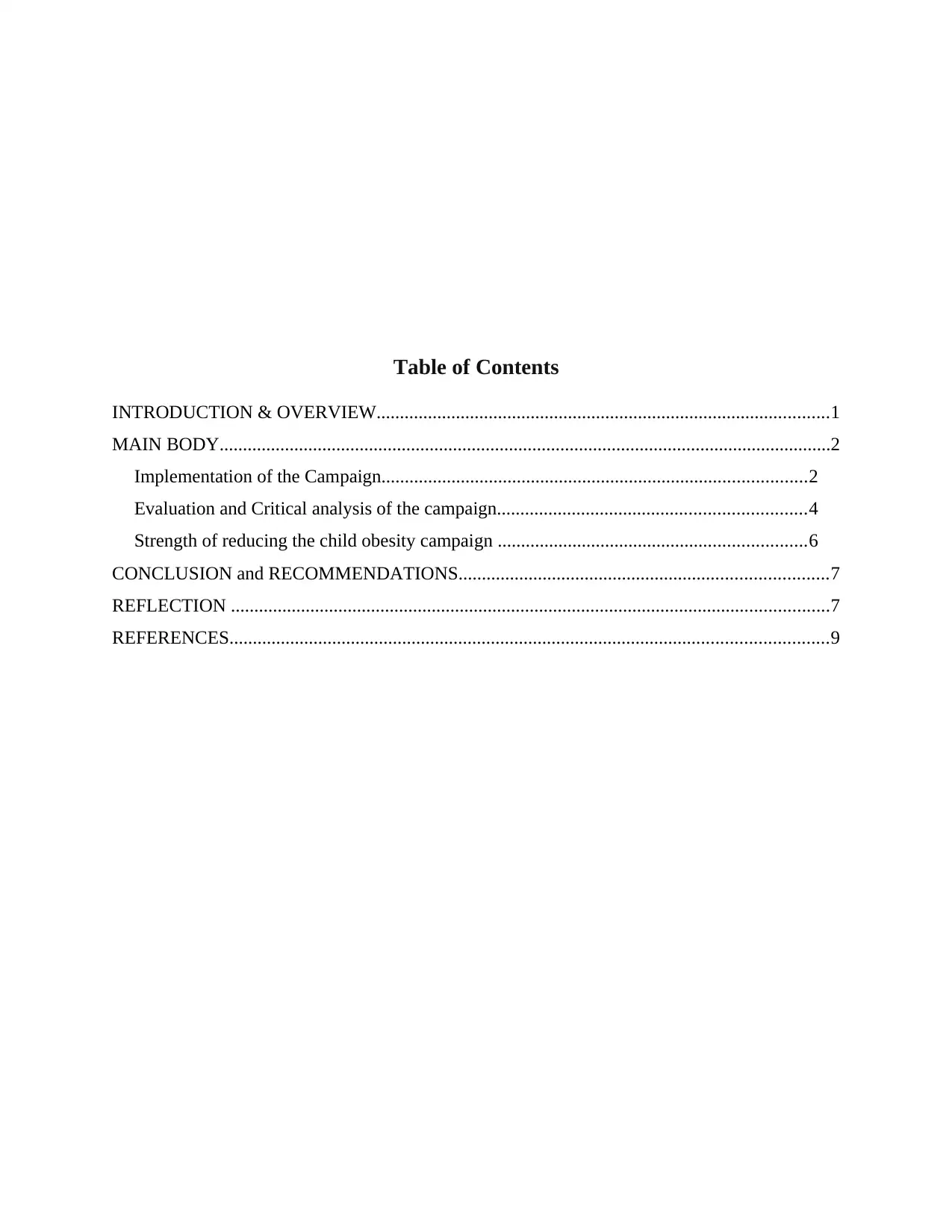
Table of Contents
INTRODUCTION & OVERVIEW.................................................................................................1
MAIN BODY...................................................................................................................................2
Implementation of the Campaign...........................................................................................2
Evaluation and Critical analysis of the campaign..................................................................4
Strength of reducing the child obesity campaign ..................................................................6
CONCLUSION and RECOMMENDATIONS...............................................................................7
REFLECTION ................................................................................................................................7
REFERENCES................................................................................................................................9
INTRODUCTION & OVERVIEW.................................................................................................1
MAIN BODY...................................................................................................................................2
Implementation of the Campaign...........................................................................................2
Evaluation and Critical analysis of the campaign..................................................................4
Strength of reducing the child obesity campaign ..................................................................6
CONCLUSION and RECOMMENDATIONS...............................................................................7
REFLECTION ................................................................................................................................7
REFERENCES................................................................................................................................9
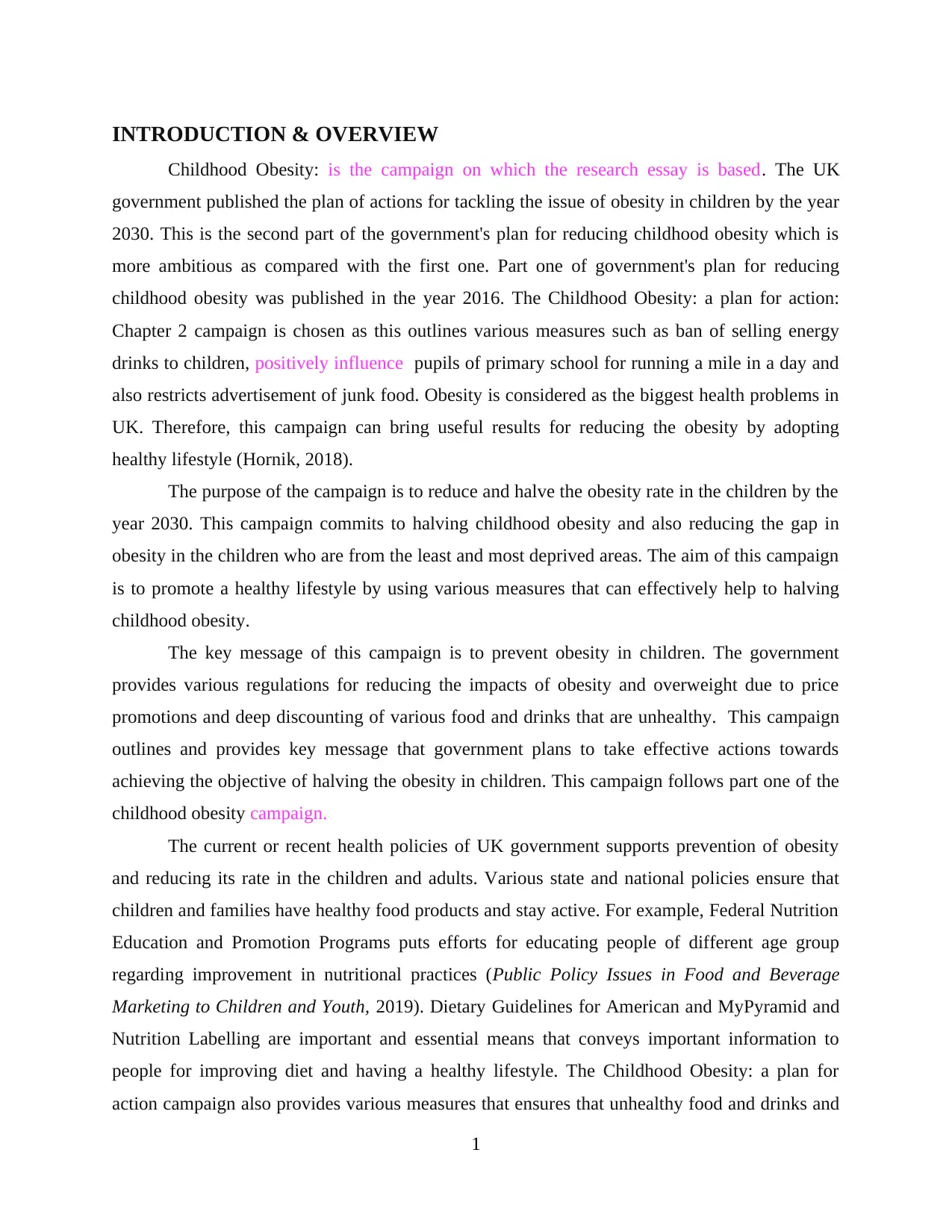
INTRODUCTION & OVERVIEW
Childhood Obesity: is the campaign on which the research essay is based. The UK
government published the plan of actions for tackling the issue of obesity in children by the year
2030. This is the second part of the government's plan for reducing childhood obesity which is
more ambitious as compared with the first one. Part one of government's plan for reducing
childhood obesity was published in the year 2016. The Childhood Obesity: a plan for action:
Chapter 2 campaign is chosen as this outlines various measures such as ban of selling energy
drinks to children, positively influence pupils of primary school for running a mile in a day and
also restricts advertisement of junk food. Obesity is considered as the biggest health problems in
UK. Therefore, this campaign can bring useful results for reducing the obesity by adopting
healthy lifestyle (Hornik, 2018).
The purpose of the campaign is to reduce and halve the obesity rate in the children by the
year 2030. This campaign commits to halving childhood obesity and also reducing the gap in
obesity in the children who are from the least and most deprived areas. The aim of this campaign
is to promote a healthy lifestyle by using various measures that can effectively help to halving
childhood obesity.
The key message of this campaign is to prevent obesity in children. The government
provides various regulations for reducing the impacts of obesity and overweight due to price
promotions and deep discounting of various food and drinks that are unhealthy. This campaign
outlines and provides key message that government plans to take effective actions towards
achieving the objective of halving the obesity in children. This campaign follows part one of the
childhood obesity campaign.
The current or recent health policies of UK government supports prevention of obesity
and reducing its rate in the children and adults. Various state and national policies ensure that
children and families have healthy food products and stay active. For example, Federal Nutrition
Education and Promotion Programs puts efforts for educating people of different age group
regarding improvement in nutritional practices (Public Policy Issues in Food and Beverage
Marketing to Children and Youth, 2019). Dietary Guidelines for American and MyPyramid and
Nutrition Labelling are important and essential means that conveys important information to
people for improving diet and having a healthy lifestyle. The Childhood Obesity: a plan for
action campaign also provides various measures that ensures that unhealthy food and drinks and
1
Childhood Obesity: is the campaign on which the research essay is based. The UK
government published the plan of actions for tackling the issue of obesity in children by the year
2030. This is the second part of the government's plan for reducing childhood obesity which is
more ambitious as compared with the first one. Part one of government's plan for reducing
childhood obesity was published in the year 2016. The Childhood Obesity: a plan for action:
Chapter 2 campaign is chosen as this outlines various measures such as ban of selling energy
drinks to children, positively influence pupils of primary school for running a mile in a day and
also restricts advertisement of junk food. Obesity is considered as the biggest health problems in
UK. Therefore, this campaign can bring useful results for reducing the obesity by adopting
healthy lifestyle (Hornik, 2018).
The purpose of the campaign is to reduce and halve the obesity rate in the children by the
year 2030. This campaign commits to halving childhood obesity and also reducing the gap in
obesity in the children who are from the least and most deprived areas. The aim of this campaign
is to promote a healthy lifestyle by using various measures that can effectively help to halving
childhood obesity.
The key message of this campaign is to prevent obesity in children. The government
provides various regulations for reducing the impacts of obesity and overweight due to price
promotions and deep discounting of various food and drinks that are unhealthy. This campaign
outlines and provides key message that government plans to take effective actions towards
achieving the objective of halving the obesity in children. This campaign follows part one of the
childhood obesity campaign.
The current or recent health policies of UK government supports prevention of obesity
and reducing its rate in the children and adults. Various state and national policies ensure that
children and families have healthy food products and stay active. For example, Federal Nutrition
Education and Promotion Programs puts efforts for educating people of different age group
regarding improvement in nutritional practices (Public Policy Issues in Food and Beverage
Marketing to Children and Youth, 2019). Dietary Guidelines for American and MyPyramid and
Nutrition Labelling are important and essential means that conveys important information to
people for improving diet and having a healthy lifestyle. The Childhood Obesity: a plan for
action campaign also provides various measures that ensures that unhealthy food and drinks and
1
⊘ This is a preview!⊘
Do you want full access?
Subscribe today to unlock all pages.

Trusted by 1+ million students worldwide
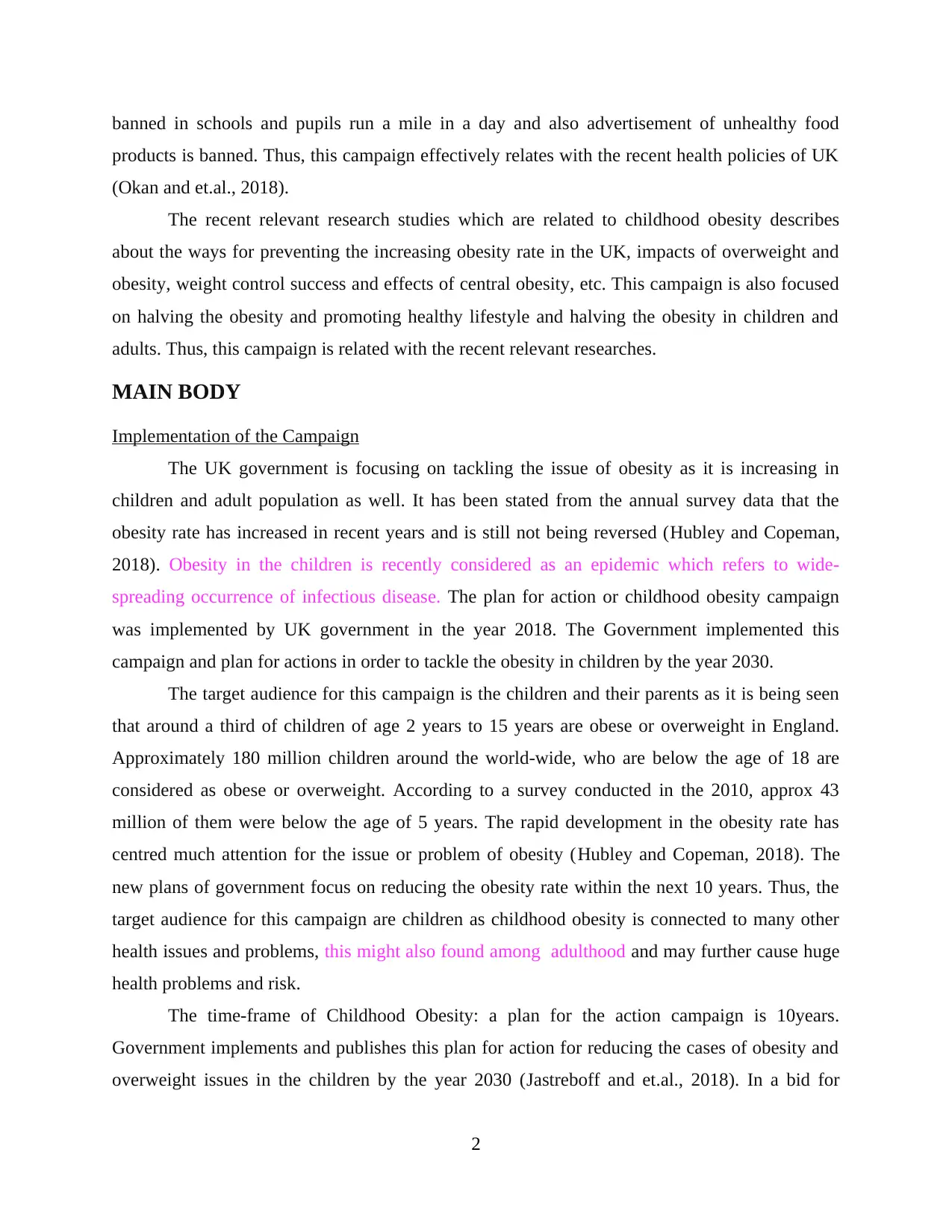
banned in schools and pupils run a mile in a day and also advertisement of unhealthy food
products is banned. Thus, this campaign effectively relates with the recent health policies of UK
(Okan and et.al., 2018).
The recent relevant research studies which are related to childhood obesity describes
about the ways for preventing the increasing obesity rate in the UK, impacts of overweight and
obesity, weight control success and effects of central obesity, etc. This campaign is also focused
on halving the obesity and promoting healthy lifestyle and halving the obesity in children and
adults. Thus, this campaign is related with the recent relevant researches.
MAIN BODY
Implementation of the Campaign
The UK government is focusing on tackling the issue of obesity as it is increasing in
children and adult population as well. It has been stated from the annual survey data that the
obesity rate has increased in recent years and is still not being reversed (Hubley and Copeman,
2018). Obesity in the children is recently considered as an epidemic which refers to wide-
spreading occurrence of infectious disease. The plan for action or childhood obesity campaign
was implemented by UK government in the year 2018. The Government implemented this
campaign and plan for actions in order to tackle the obesity in children by the year 2030.
The target audience for this campaign is the children and their parents as it is being seen
that around a third of children of age 2 years to 15 years are obese or overweight in England.
Approximately 180 million children around the world-wide, who are below the age of 18 are
considered as obese or overweight. According to a survey conducted in the 2010, approx 43
million of them were below the age of 5 years. The rapid development in the obesity rate has
centred much attention for the issue or problem of obesity (Hubley and Copeman, 2018). The
new plans of government focus on reducing the obesity rate within the next 10 years. Thus, the
target audience for this campaign are children as childhood obesity is connected to many other
health issues and problems, this might also found among adulthood and may further cause huge
health problems and risk.
The time-frame of Childhood Obesity: a plan for the action campaign is 10years.
Government implements and publishes this plan for action for reducing the cases of obesity and
overweight issues in the children by the year 2030 (Jastreboff and et.al., 2018). In a bid for
2
products is banned. Thus, this campaign effectively relates with the recent health policies of UK
(Okan and et.al., 2018).
The recent relevant research studies which are related to childhood obesity describes
about the ways for preventing the increasing obesity rate in the UK, impacts of overweight and
obesity, weight control success and effects of central obesity, etc. This campaign is also focused
on halving the obesity and promoting healthy lifestyle and halving the obesity in children and
adults. Thus, this campaign is related with the recent relevant researches.
MAIN BODY
Implementation of the Campaign
The UK government is focusing on tackling the issue of obesity as it is increasing in
children and adult population as well. It has been stated from the annual survey data that the
obesity rate has increased in recent years and is still not being reversed (Hubley and Copeman,
2018). Obesity in the children is recently considered as an epidemic which refers to wide-
spreading occurrence of infectious disease. The plan for action or childhood obesity campaign
was implemented by UK government in the year 2018. The Government implemented this
campaign and plan for actions in order to tackle the obesity in children by the year 2030.
The target audience for this campaign is the children and their parents as it is being seen
that around a third of children of age 2 years to 15 years are obese or overweight in England.
Approximately 180 million children around the world-wide, who are below the age of 18 are
considered as obese or overweight. According to a survey conducted in the 2010, approx 43
million of them were below the age of 5 years. The rapid development in the obesity rate has
centred much attention for the issue or problem of obesity (Hubley and Copeman, 2018). The
new plans of government focus on reducing the obesity rate within the next 10 years. Thus, the
target audience for this campaign are children as childhood obesity is connected to many other
health issues and problems, this might also found among adulthood and may further cause huge
health problems and risk.
The time-frame of Childhood Obesity: a plan for the action campaign is 10years.
Government implements and publishes this plan for action for reducing the cases of obesity and
overweight issues in the children by the year 2030 (Jastreboff and et.al., 2018). In a bid for
2
Paraphrase This Document
Need a fresh take? Get an instant paraphrase of this document with our AI Paraphraser
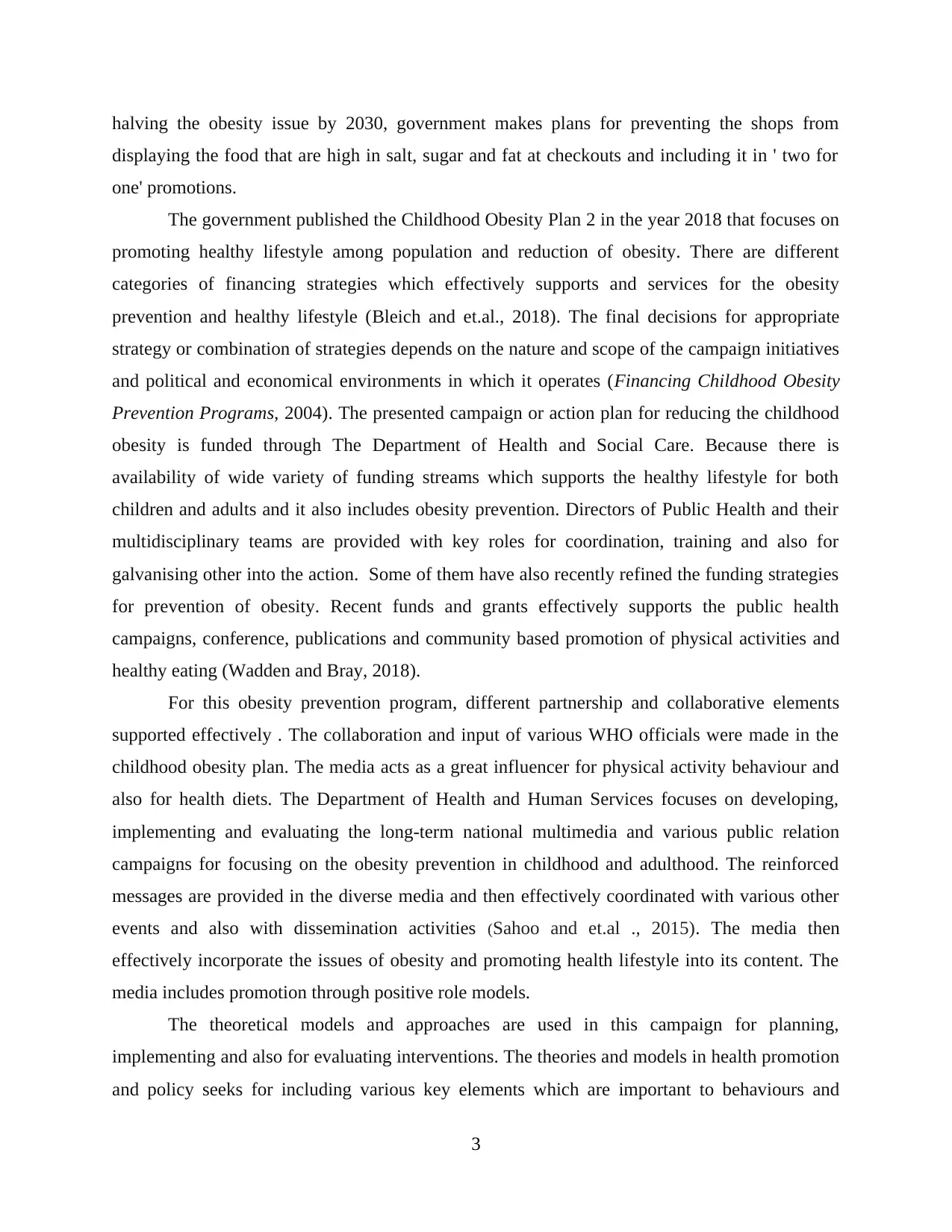
halving the obesity issue by 2030, government makes plans for preventing the shops from
displaying the food that are high in salt, sugar and fat at checkouts and including it in ' two for
one' promotions.
The government published the Childhood Obesity Plan 2 in the year 2018 that focuses on
promoting healthy lifestyle among population and reduction of obesity. There are different
categories of financing strategies which effectively supports and services for the obesity
prevention and healthy lifestyle (Bleich and et.al., 2018). The final decisions for appropriate
strategy or combination of strategies depends on the nature and scope of the campaign initiatives
and political and economical environments in which it operates (Financing Childhood Obesity
Prevention Programs, 2004). The presented campaign or action plan for reducing the childhood
obesity is funded through The Department of Health and Social Care. Because there is
availability of wide variety of funding streams which supports the healthy lifestyle for both
children and adults and it also includes obesity prevention. Directors of Public Health and their
multidisciplinary teams are provided with key roles for coordination, training and also for
galvanising other into the action. Some of them have also recently refined the funding strategies
for prevention of obesity. Recent funds and grants effectively supports the public health
campaigns, conference, publications and community based promotion of physical activities and
healthy eating (Wadden and Bray, 2018).
For this obesity prevention program, different partnership and collaborative elements
supported effectively . The collaboration and input of various WHO officials were made in the
childhood obesity plan. The media acts as a great influencer for physical activity behaviour and
also for health diets. The Department of Health and Human Services focuses on developing,
implementing and evaluating the long-term national multimedia and various public relation
campaigns for focusing on the obesity prevention in childhood and adulthood. The reinforced
messages are provided in the diverse media and then effectively coordinated with various other
events and also with dissemination activities (Sahoo and et.al ., 2015). The media then
effectively incorporate the issues of obesity and promoting health lifestyle into its content. The
media includes promotion through positive role models.
The theoretical models and approaches are used in this campaign for planning,
implementing and also for evaluating interventions. The theories and models in health promotion
and policy seeks for including various key elements which are important to behaviours and
3
displaying the food that are high in salt, sugar and fat at checkouts and including it in ' two for
one' promotions.
The government published the Childhood Obesity Plan 2 in the year 2018 that focuses on
promoting healthy lifestyle among population and reduction of obesity. There are different
categories of financing strategies which effectively supports and services for the obesity
prevention and healthy lifestyle (Bleich and et.al., 2018). The final decisions for appropriate
strategy or combination of strategies depends on the nature and scope of the campaign initiatives
and political and economical environments in which it operates (Financing Childhood Obesity
Prevention Programs, 2004). The presented campaign or action plan for reducing the childhood
obesity is funded through The Department of Health and Social Care. Because there is
availability of wide variety of funding streams which supports the healthy lifestyle for both
children and adults and it also includes obesity prevention. Directors of Public Health and their
multidisciplinary teams are provided with key roles for coordination, training and also for
galvanising other into the action. Some of them have also recently refined the funding strategies
for prevention of obesity. Recent funds and grants effectively supports the public health
campaigns, conference, publications and community based promotion of physical activities and
healthy eating (Wadden and Bray, 2018).
For this obesity prevention program, different partnership and collaborative elements
supported effectively . The collaboration and input of various WHO officials were made in the
childhood obesity plan. The media acts as a great influencer for physical activity behaviour and
also for health diets. The Department of Health and Human Services focuses on developing,
implementing and evaluating the long-term national multimedia and various public relation
campaigns for focusing on the obesity prevention in childhood and adulthood. The reinforced
messages are provided in the diverse media and then effectively coordinated with various other
events and also with dissemination activities (Sahoo and et.al ., 2015). The media then
effectively incorporate the issues of obesity and promoting health lifestyle into its content. The
media includes promotion through positive role models.
The theoretical models and approaches are used in this campaign for planning,
implementing and also for evaluating interventions. The theories and models in health promotion
and policy seeks for including various key elements which are important to behaviours and
3
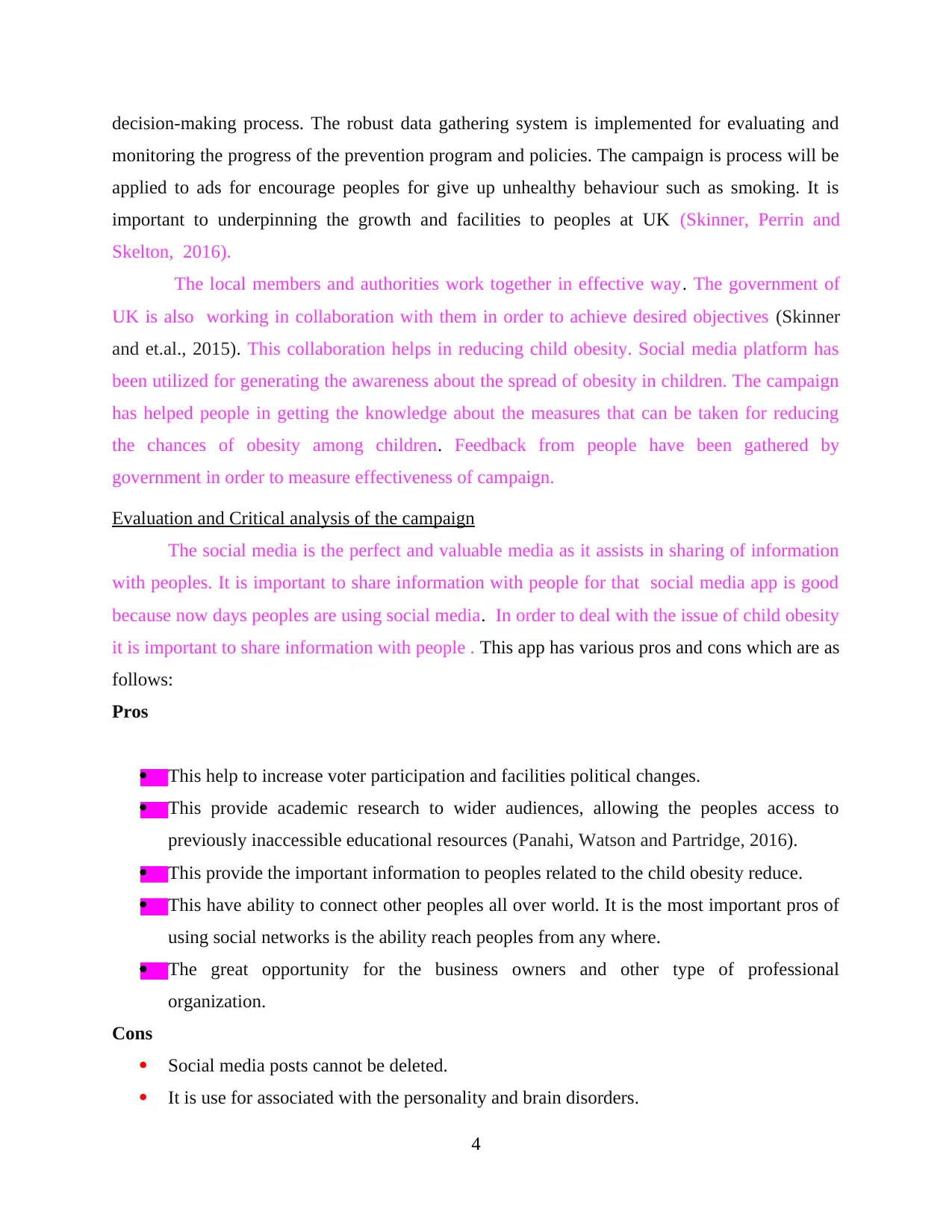
decision-making process. The robust data gathering system is implemented for evaluating and
monitoring the progress of the prevention program and policies. The campaign is process will be
applied to ads for encourage peoples for give up unhealthy behaviour such as smoking. It is
important to underpinning the growth and facilities to peoples at UK (Skinner, Perrin and
Skelton, 2016).
The local members and authorities work together in effective way. The government of
UK is also working in collaboration with them in order to achieve desired objectives (Skinner
and et.al., 2015). This collaboration helps in reducing child obesity. Social media platform has
been utilized for generating the awareness about the spread of obesity in children. The campaign
has helped people in getting the knowledge about the measures that can be taken for reducing
the chances of obesity among children. Feedback from people have been gathered by
government in order to measure effectiveness of campaign.
Evaluation and Critical analysis of the campaign
The social media is the perfect and valuable media as it assists in sharing of information
with peoples. It is important to share information with people for that social media app is good
because now days peoples are using social media. In order to deal with the issue of child obesity
it is important to share information with people . This app has various pros and cons which are as
follows:
Pros
This help to increase voter participation and facilities political changes.
This provide academic research to wider audiences, allowing the peoples access to
previously inaccessible educational resources (Panahi, Watson and Partridge, 2016).
This provide the important information to peoples related to the child obesity reduce.
This have ability to connect other peoples all over world. It is the most important pros of
using social networks is the ability reach peoples from any where.
The great opportunity for the business owners and other type of professional
organization.
Cons
Social media posts cannot be deleted.
It is use for associated with the personality and brain disorders.
4
monitoring the progress of the prevention program and policies. The campaign is process will be
applied to ads for encourage peoples for give up unhealthy behaviour such as smoking. It is
important to underpinning the growth and facilities to peoples at UK (Skinner, Perrin and
Skelton, 2016).
The local members and authorities work together in effective way. The government of
UK is also working in collaboration with them in order to achieve desired objectives (Skinner
and et.al., 2015). This collaboration helps in reducing child obesity. Social media platform has
been utilized for generating the awareness about the spread of obesity in children. The campaign
has helped people in getting the knowledge about the measures that can be taken for reducing
the chances of obesity among children. Feedback from people have been gathered by
government in order to measure effectiveness of campaign.
Evaluation and Critical analysis of the campaign
The social media is the perfect and valuable media as it assists in sharing of information
with peoples. It is important to share information with people for that social media app is good
because now days peoples are using social media. In order to deal with the issue of child obesity
it is important to share information with people . This app has various pros and cons which are as
follows:
Pros
This help to increase voter participation and facilities political changes.
This provide academic research to wider audiences, allowing the peoples access to
previously inaccessible educational resources (Panahi, Watson and Partridge, 2016).
This provide the important information to peoples related to the child obesity reduce.
This have ability to connect other peoples all over world. It is the most important pros of
using social networks is the ability reach peoples from any where.
The great opportunity for the business owners and other type of professional
organization.
Cons
Social media posts cannot be deleted.
It is use for associated with the personality and brain disorders.
4
⊘ This is a preview!⊘
Do you want full access?
Subscribe today to unlock all pages.

Trusted by 1+ million students worldwide
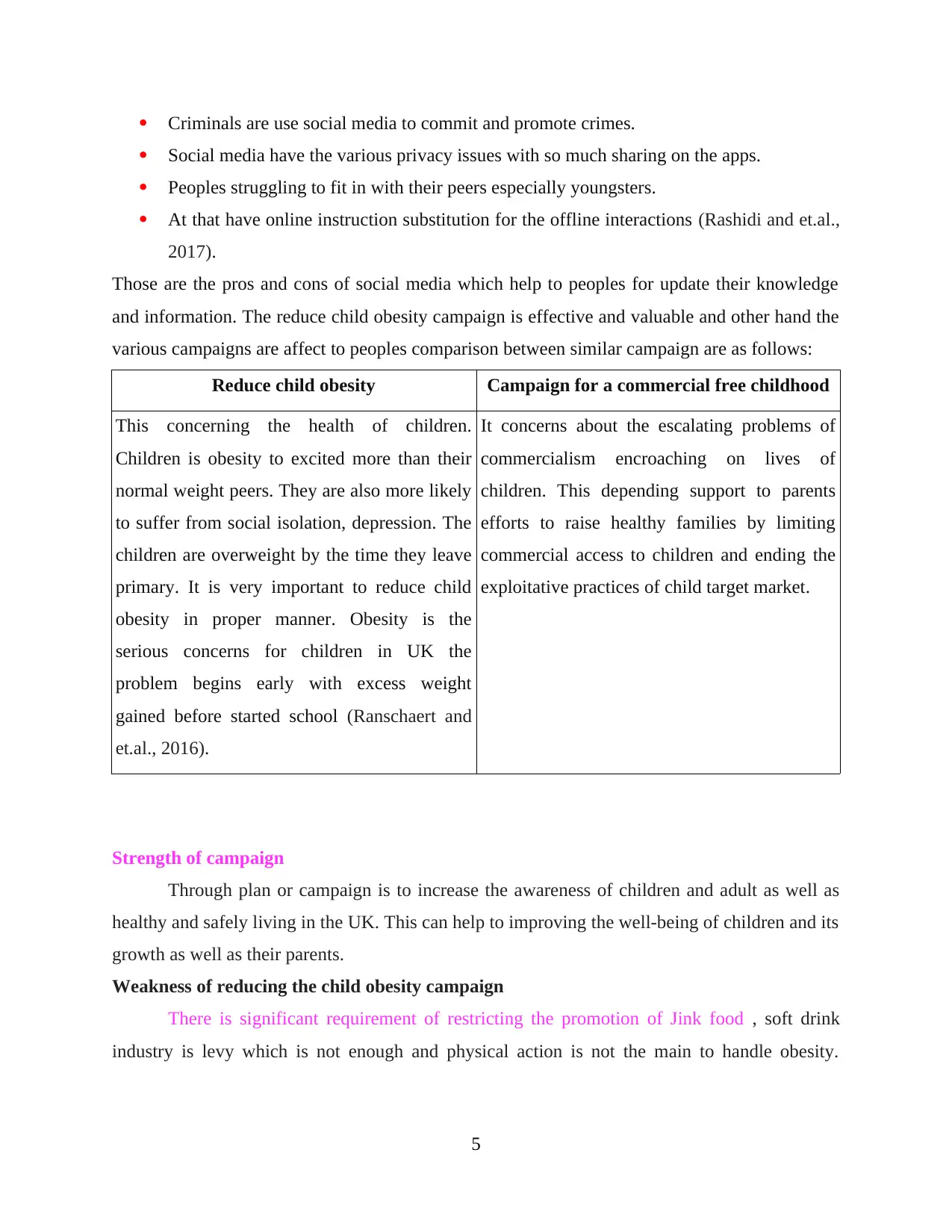
Criminals are use social media to commit and promote crimes.
Social media have the various privacy issues with so much sharing on the apps.
Peoples struggling to fit in with their peers especially youngsters.
At that have online instruction substitution for the offline interactions (Rashidi and et.al.,
2017).
Those are the pros and cons of social media which help to peoples for update their knowledge
and information. The reduce child obesity campaign is effective and valuable and other hand the
various campaigns are affect to peoples comparison between similar campaign are as follows:
Reduce child obesity Campaign for a commercial free childhood
This concerning the health of children.
Children is obesity to excited more than their
normal weight peers. They are also more likely
to suffer from social isolation, depression. The
children are overweight by the time they leave
primary. It is very important to reduce child
obesity in proper manner. Obesity is the
serious concerns for children in UK the
problem begins early with excess weight
gained before started school (Ranschaert and
et.al., 2016).
It concerns about the escalating problems of
commercialism encroaching on lives of
children. This depending support to parents
efforts to raise healthy families by limiting
commercial access to children and ending the
exploitative practices of child target market.
Strength of campaign
Through plan or campaign is to increase the awareness of children and adult as well as
healthy and safely living in the UK. This can help to improving the well-being of children and its
growth as well as their parents.
Weakness of reducing the child obesity campaign
There is significant requirement of restricting the promotion of Jink food , soft drink
industry is levy which is not enough and physical action is not the main to handle obesity.
5
Social media have the various privacy issues with so much sharing on the apps.
Peoples struggling to fit in with their peers especially youngsters.
At that have online instruction substitution for the offline interactions (Rashidi and et.al.,
2017).
Those are the pros and cons of social media which help to peoples for update their knowledge
and information. The reduce child obesity campaign is effective and valuable and other hand the
various campaigns are affect to peoples comparison between similar campaign are as follows:
Reduce child obesity Campaign for a commercial free childhood
This concerning the health of children.
Children is obesity to excited more than their
normal weight peers. They are also more likely
to suffer from social isolation, depression. The
children are overweight by the time they leave
primary. It is very important to reduce child
obesity in proper manner. Obesity is the
serious concerns for children in UK the
problem begins early with excess weight
gained before started school (Ranschaert and
et.al., 2016).
It concerns about the escalating problems of
commercialism encroaching on lives of
children. This depending support to parents
efforts to raise healthy families by limiting
commercial access to children and ending the
exploitative practices of child target market.
Strength of campaign
Through plan or campaign is to increase the awareness of children and adult as well as
healthy and safely living in the UK. This can help to improving the well-being of children and its
growth as well as their parents.
Weakness of reducing the child obesity campaign
There is significant requirement of restricting the promotion of Jink food , soft drink
industry is levy which is not enough and physical action is not the main to handle obesity.
5
Paraphrase This Document
Need a fresh take? Get an instant paraphrase of this document with our AI Paraphraser
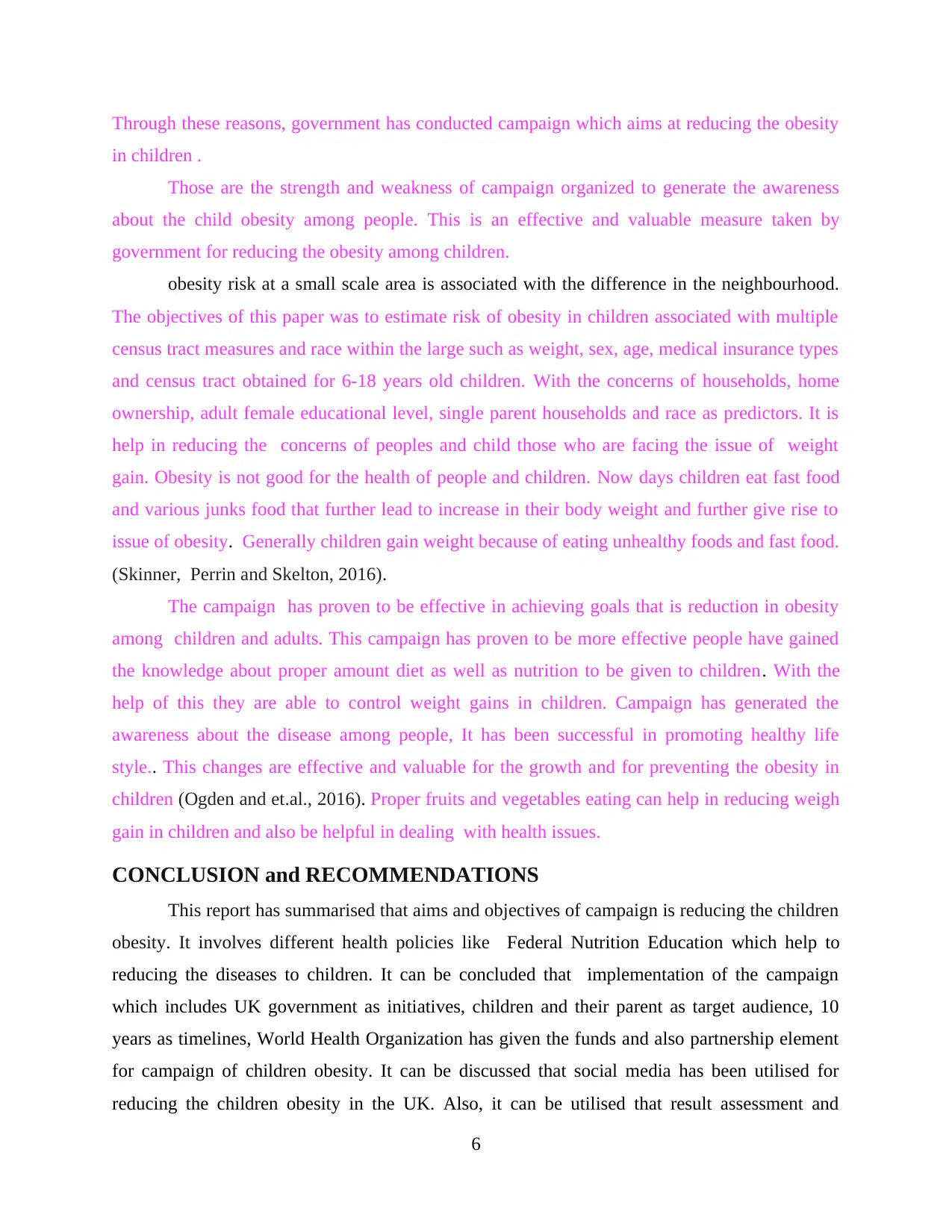
Through these reasons, government has conducted campaign which aims at reducing the obesity
in children .
Those are the strength and weakness of campaign organized to generate the awareness
about the child obesity among people. This is an effective and valuable measure taken by
government for reducing the obesity among children.
obesity risk at a small scale area is associated with the difference in the neighbourhood.
The objectives of this paper was to estimate risk of obesity in children associated with multiple
census tract measures and race within the large such as weight, sex, age, medical insurance types
and census tract obtained for 6-18 years old children. With the concerns of households, home
ownership, adult female educational level, single parent households and race as predictors. It is
help in reducing the concerns of peoples and child those who are facing the issue of weight
gain. Obesity is not good for the health of people and children. Now days children eat fast food
and various junks food that further lead to increase in their body weight and further give rise to
issue of obesity. Generally children gain weight because of eating unhealthy foods and fast food.
(Skinner, Perrin and Skelton, 2016).
The campaign has proven to be effective in achieving goals that is reduction in obesity
among children and adults. This campaign has proven to be more effective people have gained
the knowledge about proper amount diet as well as nutrition to be given to children. With the
help of this they are able to control weight gains in children. Campaign has generated the
awareness about the disease among people, It has been successful in promoting healthy life
style.. This changes are effective and valuable for the growth and for preventing the obesity in
children (Ogden and et.al., 2016). Proper fruits and vegetables eating can help in reducing weigh
gain in children and also be helpful in dealing with health issues.
CONCLUSION and RECOMMENDATIONS
This report has summarised that aims and objectives of campaign is reducing the children
obesity. It involves different health policies like Federal Nutrition Education which help to
reducing the diseases to children. It can be concluded that implementation of the campaign
which includes UK government as initiatives, children and their parent as target audience, 10
years as timelines, World Health Organization has given the funds and also partnership element
for campaign of children obesity. It can be discussed that social media has been utilised for
reducing the children obesity in the UK. Also, it can be utilised that result assessment and
6
in children .
Those are the strength and weakness of campaign organized to generate the awareness
about the child obesity among people. This is an effective and valuable measure taken by
government for reducing the obesity among children.
obesity risk at a small scale area is associated with the difference in the neighbourhood.
The objectives of this paper was to estimate risk of obesity in children associated with multiple
census tract measures and race within the large such as weight, sex, age, medical insurance types
and census tract obtained for 6-18 years old children. With the concerns of households, home
ownership, adult female educational level, single parent households and race as predictors. It is
help in reducing the concerns of peoples and child those who are facing the issue of weight
gain. Obesity is not good for the health of people and children. Now days children eat fast food
and various junks food that further lead to increase in their body weight and further give rise to
issue of obesity. Generally children gain weight because of eating unhealthy foods and fast food.
(Skinner, Perrin and Skelton, 2016).
The campaign has proven to be effective in achieving goals that is reduction in obesity
among children and adults. This campaign has proven to be more effective people have gained
the knowledge about proper amount diet as well as nutrition to be given to children. With the
help of this they are able to control weight gains in children. Campaign has generated the
awareness about the disease among people, It has been successful in promoting healthy life
style.. This changes are effective and valuable for the growth and for preventing the obesity in
children (Ogden and et.al., 2016). Proper fruits and vegetables eating can help in reducing weigh
gain in children and also be helpful in dealing with health issues.
CONCLUSION and RECOMMENDATIONS
This report has summarised that aims and objectives of campaign is reducing the children
obesity. It involves different health policies like Federal Nutrition Education which help to
reducing the diseases to children. It can be concluded that implementation of the campaign
which includes UK government as initiatives, children and their parent as target audience, 10
years as timelines, World Health Organization has given the funds and also partnership element
for campaign of children obesity. It can be discussed that social media has been utilised for
reducing the children obesity in the UK. Also, it can be utilised that result assessment and
6
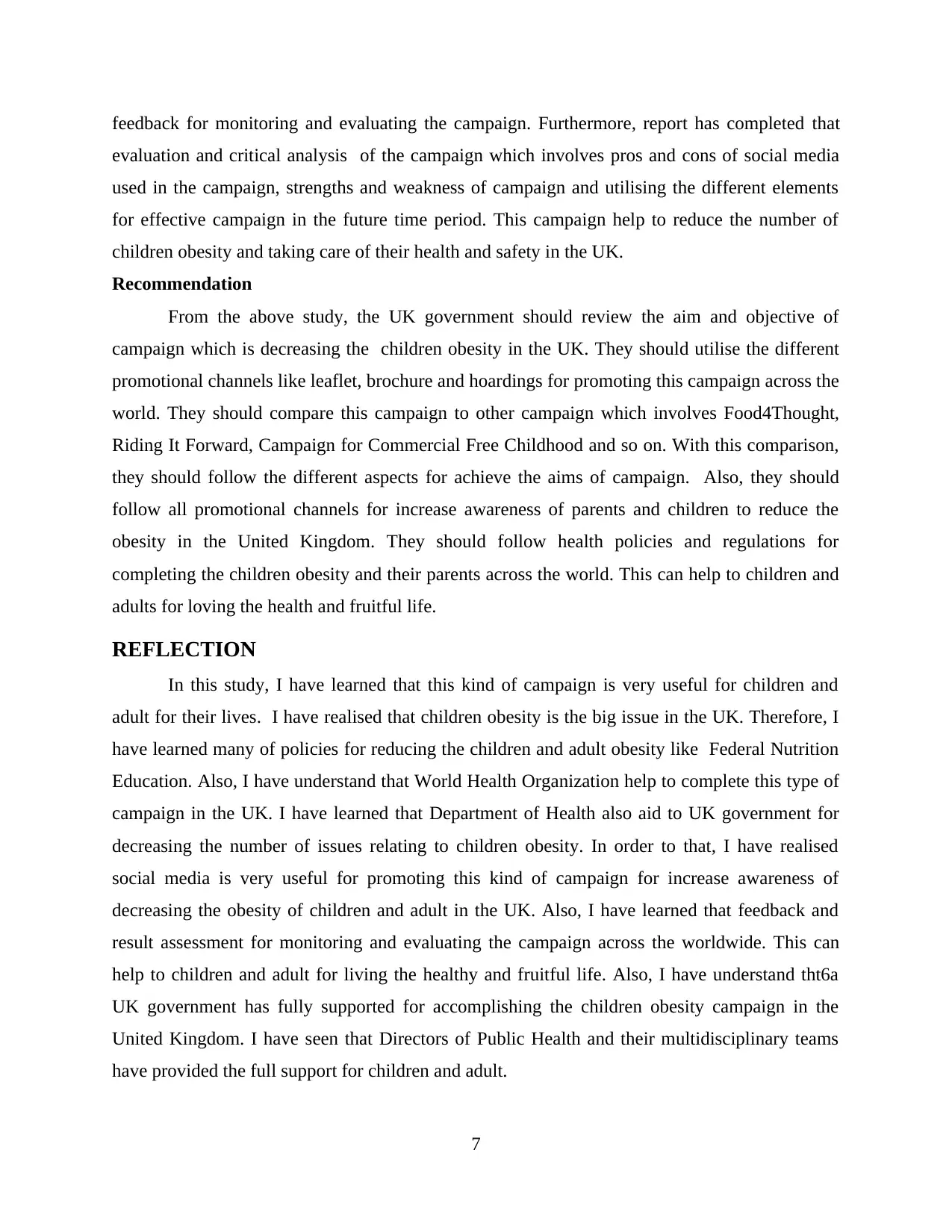
feedback for monitoring and evaluating the campaign. Furthermore, report has completed that
evaluation and critical analysis of the campaign which involves pros and cons of social media
used in the campaign, strengths and weakness of campaign and utilising the different elements
for effective campaign in the future time period. This campaign help to reduce the number of
children obesity and taking care of their health and safety in the UK.
Recommendation
From the above study, the UK government should review the aim and objective of
campaign which is decreasing the children obesity in the UK. They should utilise the different
promotional channels like leaflet, brochure and hoardings for promoting this campaign across the
world. They should compare this campaign to other campaign which involves Food4Thought,
Riding It Forward, Campaign for Commercial Free Childhood and so on. With this comparison,
they should follow the different aspects for achieve the aims of campaign. Also, they should
follow all promotional channels for increase awareness of parents and children to reduce the
obesity in the United Kingdom. They should follow health policies and regulations for
completing the children obesity and their parents across the world. This can help to children and
adults for loving the health and fruitful life.
REFLECTION
In this study, I have learned that this kind of campaign is very useful for children and
adult for their lives. I have realised that children obesity is the big issue in the UK. Therefore, I
have learned many of policies for reducing the children and adult obesity like Federal Nutrition
Education. Also, I have understand that World Health Organization help to complete this type of
campaign in the UK. I have learned that Department of Health also aid to UK government for
decreasing the number of issues relating to children obesity. In order to that, I have realised
social media is very useful for promoting this kind of campaign for increase awareness of
decreasing the obesity of children and adult in the UK. Also, I have learned that feedback and
result assessment for monitoring and evaluating the campaign across the worldwide. This can
help to children and adult for living the healthy and fruitful life. Also, I have understand tht6a
UK government has fully supported for accomplishing the children obesity campaign in the
United Kingdom. I have seen that Directors of Public Health and their multidisciplinary teams
have provided the full support for children and adult.
7
evaluation and critical analysis of the campaign which involves pros and cons of social media
used in the campaign, strengths and weakness of campaign and utilising the different elements
for effective campaign in the future time period. This campaign help to reduce the number of
children obesity and taking care of their health and safety in the UK.
Recommendation
From the above study, the UK government should review the aim and objective of
campaign which is decreasing the children obesity in the UK. They should utilise the different
promotional channels like leaflet, brochure and hoardings for promoting this campaign across the
world. They should compare this campaign to other campaign which involves Food4Thought,
Riding It Forward, Campaign for Commercial Free Childhood and so on. With this comparison,
they should follow the different aspects for achieve the aims of campaign. Also, they should
follow all promotional channels for increase awareness of parents and children to reduce the
obesity in the United Kingdom. They should follow health policies and regulations for
completing the children obesity and their parents across the world. This can help to children and
adults for loving the health and fruitful life.
REFLECTION
In this study, I have learned that this kind of campaign is very useful for children and
adult for their lives. I have realised that children obesity is the big issue in the UK. Therefore, I
have learned many of policies for reducing the children and adult obesity like Federal Nutrition
Education. Also, I have understand that World Health Organization help to complete this type of
campaign in the UK. I have learned that Department of Health also aid to UK government for
decreasing the number of issues relating to children obesity. In order to that, I have realised
social media is very useful for promoting this kind of campaign for increase awareness of
decreasing the obesity of children and adult in the UK. Also, I have learned that feedback and
result assessment for monitoring and evaluating the campaign across the worldwide. This can
help to children and adult for living the healthy and fruitful life. Also, I have understand tht6a
UK government has fully supported for accomplishing the children obesity campaign in the
United Kingdom. I have seen that Directors of Public Health and their multidisciplinary teams
have provided the full support for children and adult.
7
⊘ This is a preview!⊘
Do you want full access?
Subscribe today to unlock all pages.

Trusted by 1+ million students worldwide
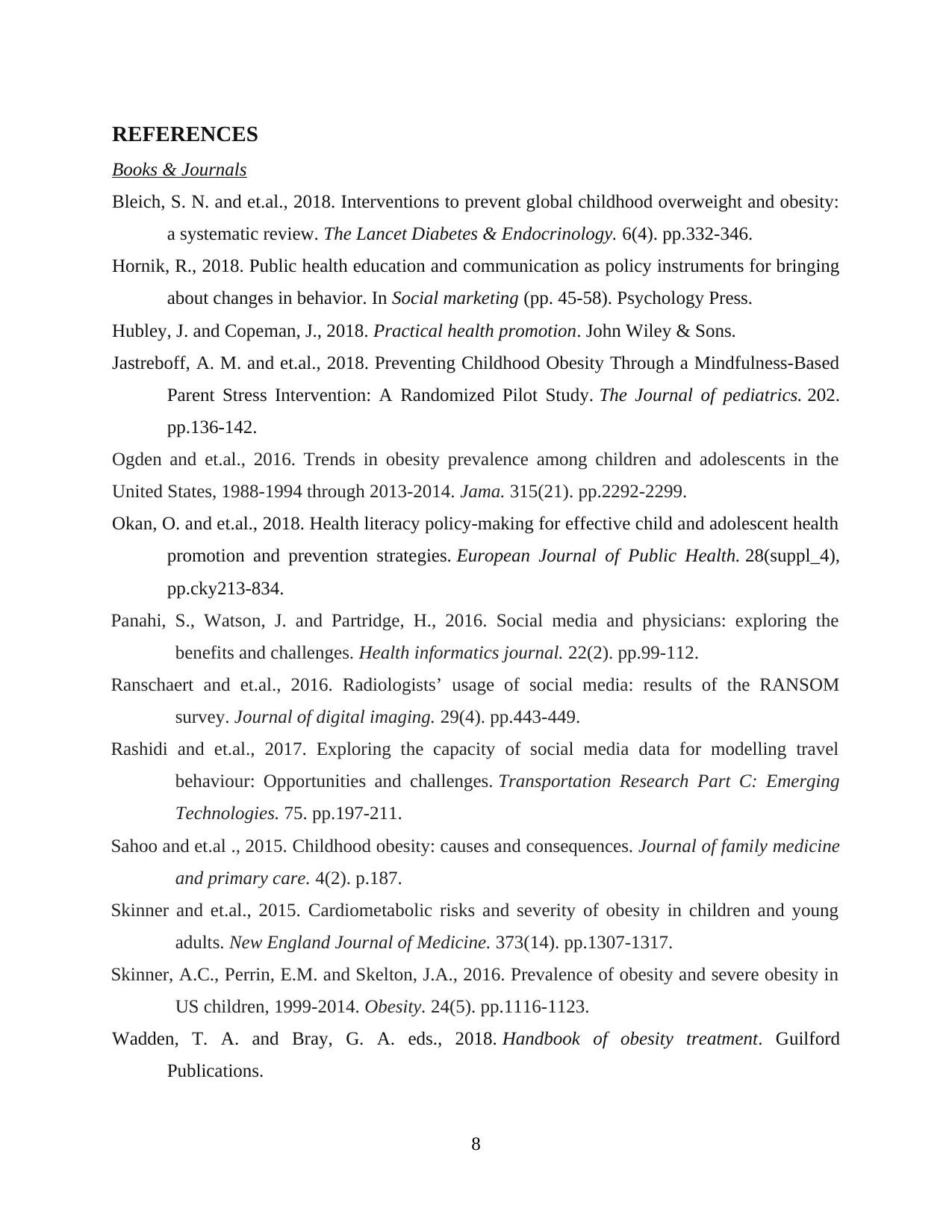
REFERENCES
Books & Journals
Bleich, S. N. and et.al., 2018. Interventions to prevent global childhood overweight and obesity:
a systematic review. The Lancet Diabetes & Endocrinology. 6(4). pp.332-346.
Hornik, R., 2018. Public health education and communication as policy instruments for bringing
about changes in behavior. In Social marketing (pp. 45-58). Psychology Press.
Hubley, J. and Copeman, J., 2018. Practical health promotion. John Wiley & Sons.
Jastreboff, A. M. and et.al., 2018. Preventing Childhood Obesity Through a Mindfulness-Based
Parent Stress Intervention: A Randomized Pilot Study. The Journal of pediatrics. 202.
pp.136-142.
Ogden and et.al., 2016. Trends in obesity prevalence among children and adolescents in the
United States, 1988-1994 through 2013-2014. Jama. 315(21). pp.2292-2299.
Okan, O. and et.al., 2018. Health literacy policy-making for effective child and adolescent health
promotion and prevention strategies. European Journal of Public Health. 28(suppl_4),
pp.cky213-834.
Panahi, S., Watson, J. and Partridge, H., 2016. Social media and physicians: exploring the
benefits and challenges. Health informatics journal. 22(2). pp.99-112.
Ranschaert and et.al., 2016. Radiologists’ usage of social media: results of the RANSOM
survey. Journal of digital imaging. 29(4). pp.443-449.
Rashidi and et.al., 2017. Exploring the capacity of social media data for modelling travel
behaviour: Opportunities and challenges. Transportation Research Part C: Emerging
Technologies. 75. pp.197-211.
Sahoo and et.al ., 2015. Childhood obesity: causes and consequences. Journal of family medicine
and primary care. 4(2). p.187.
Skinner and et.al., 2015. Cardiometabolic risks and severity of obesity in children and young
adults. New England Journal of Medicine. 373(14). pp.1307-1317.
Skinner, A.C., Perrin, E.M. and Skelton, J.A., 2016. Prevalence of obesity and severe obesity in
US children, 1999‐2014. Obesity. 24(5). pp.1116-1123.
Wadden, T. A. and Bray, G. A. eds., 2018. Handbook of obesity treatment. Guilford
Publications.
8
Books & Journals
Bleich, S. N. and et.al., 2018. Interventions to prevent global childhood overweight and obesity:
a systematic review. The Lancet Diabetes & Endocrinology. 6(4). pp.332-346.
Hornik, R., 2018. Public health education and communication as policy instruments for bringing
about changes in behavior. In Social marketing (pp. 45-58). Psychology Press.
Hubley, J. and Copeman, J., 2018. Practical health promotion. John Wiley & Sons.
Jastreboff, A. M. and et.al., 2018. Preventing Childhood Obesity Through a Mindfulness-Based
Parent Stress Intervention: A Randomized Pilot Study. The Journal of pediatrics. 202.
pp.136-142.
Ogden and et.al., 2016. Trends in obesity prevalence among children and adolescents in the
United States, 1988-1994 through 2013-2014. Jama. 315(21). pp.2292-2299.
Okan, O. and et.al., 2018. Health literacy policy-making for effective child and adolescent health
promotion and prevention strategies. European Journal of Public Health. 28(suppl_4),
pp.cky213-834.
Panahi, S., Watson, J. and Partridge, H., 2016. Social media and physicians: exploring the
benefits and challenges. Health informatics journal. 22(2). pp.99-112.
Ranschaert and et.al., 2016. Radiologists’ usage of social media: results of the RANSOM
survey. Journal of digital imaging. 29(4). pp.443-449.
Rashidi and et.al., 2017. Exploring the capacity of social media data for modelling travel
behaviour: Opportunities and challenges. Transportation Research Part C: Emerging
Technologies. 75. pp.197-211.
Sahoo and et.al ., 2015. Childhood obesity: causes and consequences. Journal of family medicine
and primary care. 4(2). p.187.
Skinner and et.al., 2015. Cardiometabolic risks and severity of obesity in children and young
adults. New England Journal of Medicine. 373(14). pp.1307-1317.
Skinner, A.C., Perrin, E.M. and Skelton, J.A., 2016. Prevalence of obesity and severe obesity in
US children, 1999‐2014. Obesity. 24(5). pp.1116-1123.
Wadden, T. A. and Bray, G. A. eds., 2018. Handbook of obesity treatment. Guilford
Publications.
8
Paraphrase This Document
Need a fresh take? Get an instant paraphrase of this document with our AI Paraphraser
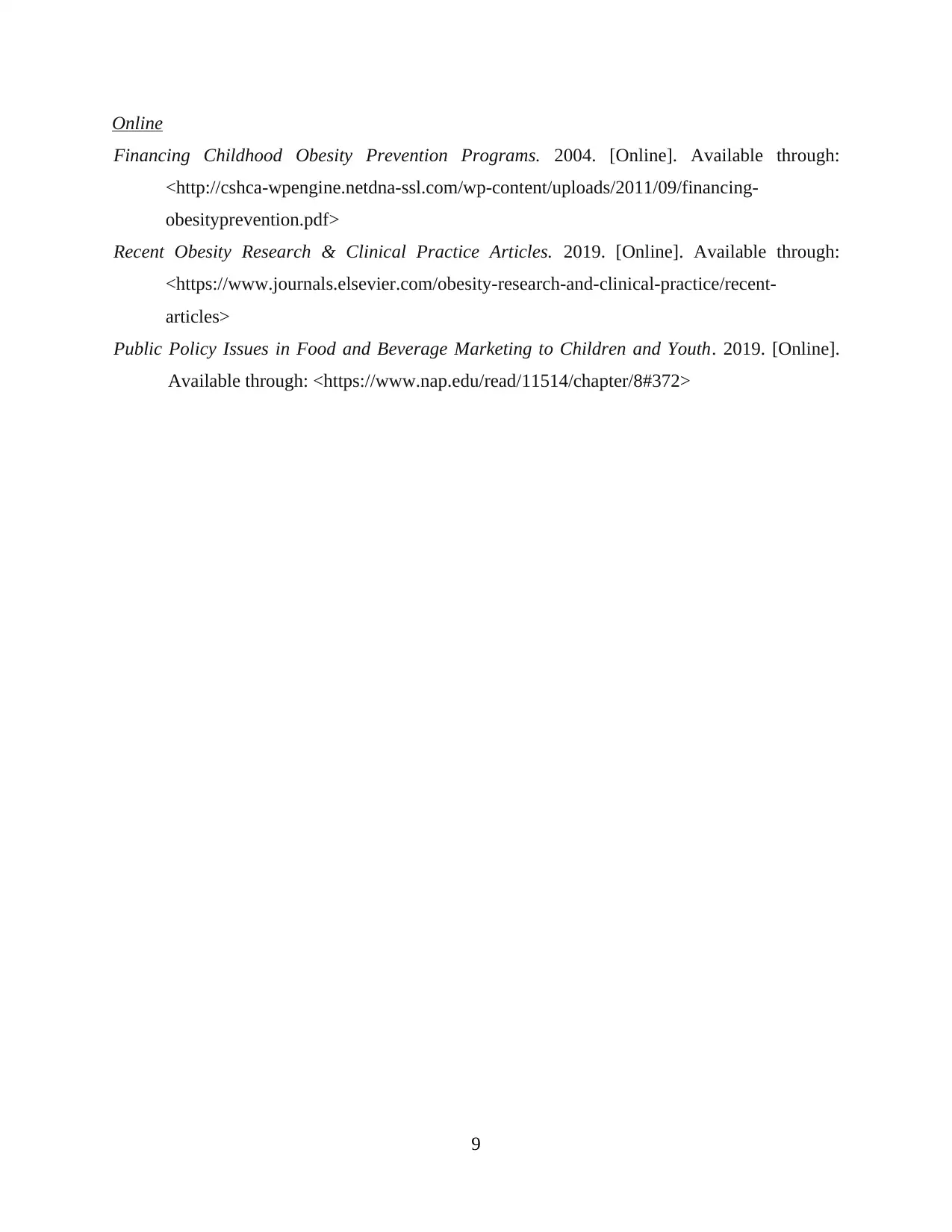
Online
Financing Childhood Obesity Prevention Programs. 2004. [Online]. Available through:
<http://cshca-wpengine.netdna-ssl.com/wp-content/uploads/2011/09/financing-
obesityprevention.pdf>
Recent Obesity Research & Clinical Practice Articles. 2019. [Online]. Available through:
<https://www.journals.elsevier.com/obesity-research-and-clinical-practice/recent-
articles>
Public Policy Issues in Food and Beverage Marketing to Children and Youth. 2019. [Online].
Available through: <https://www.nap.edu/read/11514/chapter/8#372>
9
Financing Childhood Obesity Prevention Programs. 2004. [Online]. Available through:
<http://cshca-wpengine.netdna-ssl.com/wp-content/uploads/2011/09/financing-
obesityprevention.pdf>
Recent Obesity Research & Clinical Practice Articles. 2019. [Online]. Available through:
<https://www.journals.elsevier.com/obesity-research-and-clinical-practice/recent-
articles>
Public Policy Issues in Food and Beverage Marketing to Children and Youth. 2019. [Online].
Available through: <https://www.nap.edu/read/11514/chapter/8#372>
9
1 out of 11
Related Documents
Your All-in-One AI-Powered Toolkit for Academic Success.
+13062052269
info@desklib.com
Available 24*7 on WhatsApp / Email
![[object Object]](/_next/static/media/star-bottom.7253800d.svg)
Unlock your academic potential
Copyright © 2020–2025 A2Z Services. All Rights Reserved. Developed and managed by ZUCOL.





